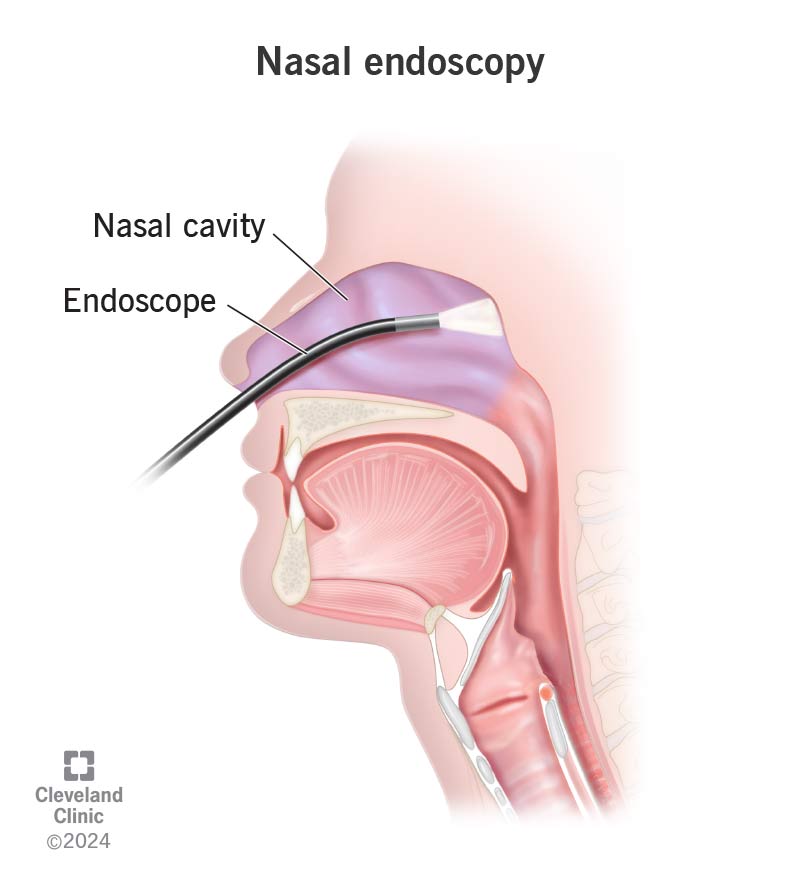During nasal endoscopy, your healthcare provider inserts an endoscope (a thin, flexible tube with a light and camera) into your nose. This gives them a clear, inside view of your sinuses and nasal passages. Healthcare providers use nasal endoscopy to diagnose and treat a range of conditions affecting your nose and sinuses.
Advertisement
Cleveland Clinic is a non-profit academic medical center. Advertising on our site helps support our mission. We do not endorse non-Cleveland Clinic products or services. Policy

Nasal endoscopy (en-DAH-skuh-pee) is a procedure to look at the inside of your nasal cavity and openings to your sinuses. Rhinoscopy and nasoendoscopy are other names healthcare providers use to describe the same procedure.
Advertisement
Cleveland Clinic is a non-profit academic medical center. Advertising on our site helps support our mission. We do not endorse non-Cleveland Clinic products or services. Policy
During nasal endoscopy, a provider inserts an endoscope (a long tube with a tiny camera and a light) into your nose. This helps them examine your nasal and sinus areas. The camera captures video images and projects them onto a screen.
Healthcare providers use nasal endoscopy when they need to look at the inside of your nose and sinuses. They use it to diagnose persistent symptoms like:
Your provider can also use nasal endoscopy to help them:
You probably won’t need to make special preparations before your nasal endoscopy. Your healthcare provider can tell you if you need to do anything specific before your visit.
If you take blood thinners, tell your healthcare provider. You might need to stop taking them temporarily. But this is rarely the case.
Nasal endoscopy is an outpatient procedure that takes about one to five minutes to complete. It doesn’t require sedation, so you’ll be awake and able to communicate with your provider.
Your healthcare provider will:
Advertisement
Nasal endoscopy shouldn’t hurt. But you’ll probably feel pressure during the procedure.
The anesthetic spray might numb your mouth and throat in addition to your nose. Due to the lingering numbness, it’s a good idea to avoid eating and drinking for about an hour after your nasal endoscopy.
Your healthcare provider will let you know if you need to follow any additional instructions.
Nasal endoscopy side effects may include slight soreness in your nose and throat. You might even have mild nosebleeds. These side effects usually go away on their own in a couple of days.
Follow your healthcare provider’s recommendations regarding follow-ups and medications. They may schedule you for another nasal endoscopy later on to check your progress.
Nasal endoscopy is generally safe. But there are possible complications, including:
Specific risks depend on several factors, including your age and other existing health conditions. Be sure to ask your healthcare provider about potential complications during your consultation.
Your healthcare provider might review the results of your nasal endoscopy with you right away. If they need more information to design a treatment plan, they may order more imaging tests, like a CT scan.
Call your healthcare provider any time you have questions or concerns regarding nasal endoscopy.
If you’ve already had the procedure, let your provider know if you develop pain, fever or other worrisome symptoms.
Hearing that you need a diagnostic procedure can feel a bit scary. But if you have nasal or sinus symptoms that don’t go away, nasal endoscopy can help your healthcare provider find the right treatment. This procedure only takes five minutes, but it can tell you a lot about your health. Ask your provider if nasal endoscopy is right for you.
Advertisement
Constant stuffiness, sinus pressure and pain can wear you out. But you don’t have to live with it. Cleveland Clinic sinus surgery experts can help you get relief.

Last reviewed on 02/25/2025.
Learn more about the Health Library and our editorial process.